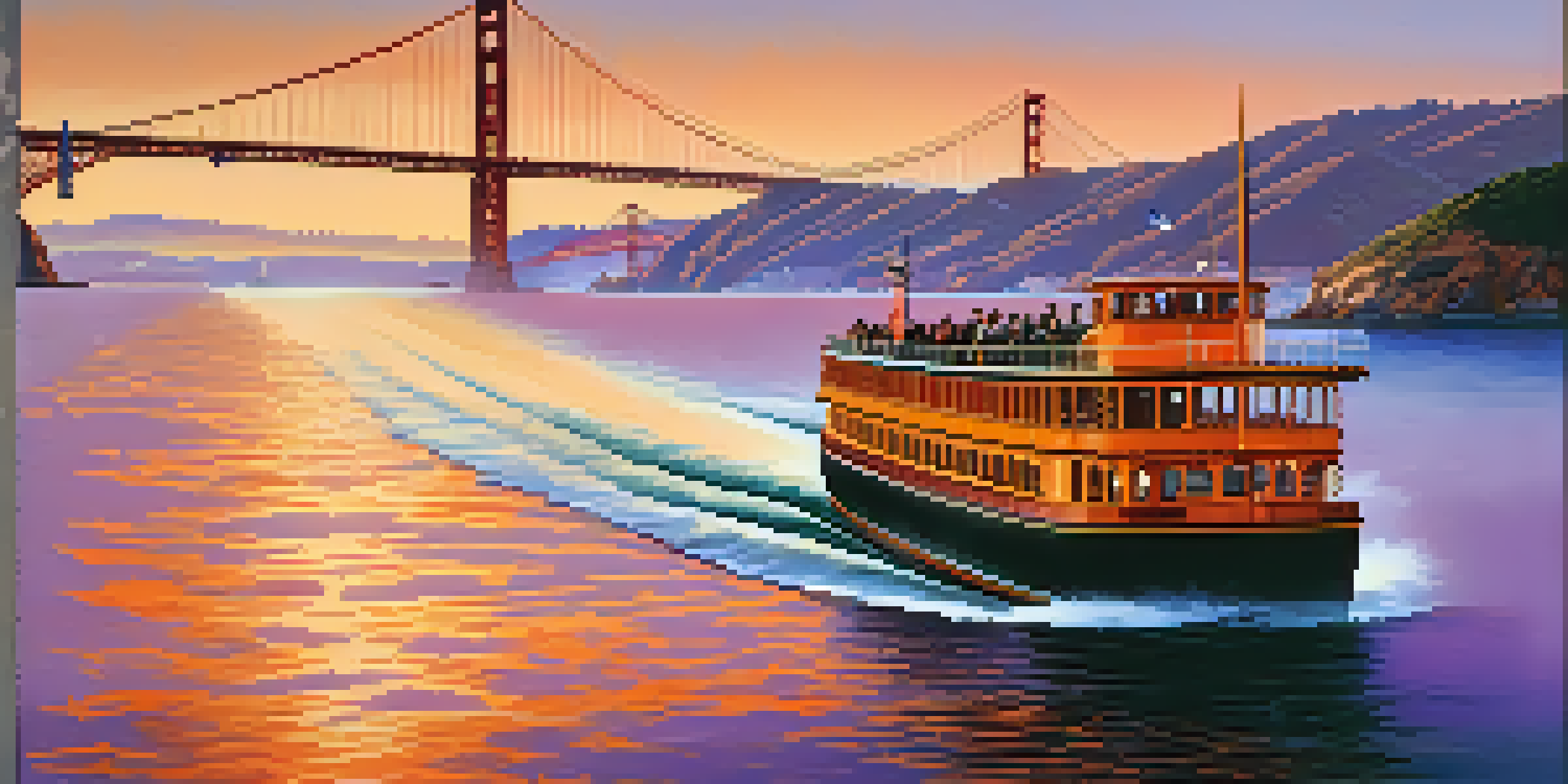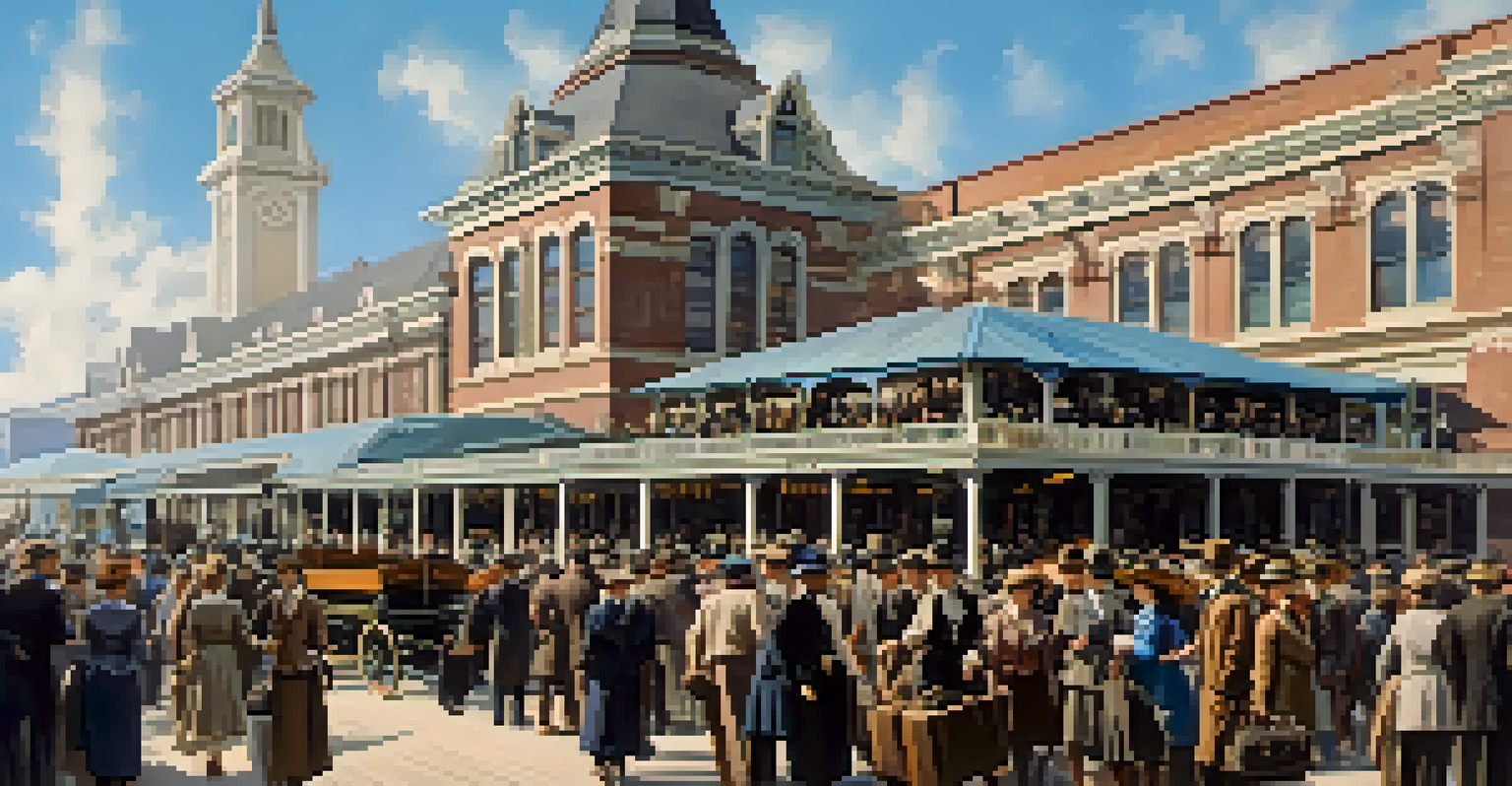The Role of Ferries in San Francisco's Transportation History

Ferries: The Lifeline of Early San Francisco
In the early days of San Francisco, before the famous bridges, ferries served as the primary means of crossing the bay. They connected the bustling city to surrounding areas, allowing for trade and travel. Imagine the excitement of passengers boarding wooden boats, eager to explore the vibrant markets and communities across the water. These ferries were not just vessels; they were the heartbeat of a growing metropolis, facilitating commerce and social interaction.
The ferry is a bridge that connects not just land, but people, culture, and opportunity.
As the Gold Rush swept through California in the mid-1800s, ferry service became essential for miners and settlers flocking to the region. The influx of people created a demand for efficient transportation, and ferries quickly adapted to meet these needs. They provided a crucial link between San Francisco and other towns, turning the bay into a bustling highway of activity. This era solidified the importance of ferries in shaping the city's economic landscape.
The charm of these early ferries lay in their simplicity and accessibility. They were often the only affordable option for many residents, offering a unique experience as passengers enjoyed scenic views of the bay. Today, many still reminisce about those moments, highlighting how ferries were more than just a mode of transport; they fostered connections among communities and contributed to the city’s identity.
The Evolution of Ferry Services Over Time
As technology progressed, so did the ferries of San Francisco. The transition from wooden vessels to steam-powered boats marked a significant milestone in the late 19th century. This advancement allowed for faster travel times and improved safety, making ferries even more popular among commuters. It was a period of innovation that laid the groundwork for modern ferry services.

The early 20th century saw the introduction of larger, more comfortable vessels catering to the growing population. Ferries became a practical choice for daily commuters, with routes connecting major neighborhoods and suburbs. This accessibility changed the way people lived and worked, reinforcing the idea that a reliable public transportation system was vital for urban growth.
Ferries: Key to Early San Francisco
Ferries were essential for connecting San Francisco to surrounding areas, facilitating trade and travel during the city's formative years.
Despite the rise of automobiles and bridges, ferries continued to adapt and thrive. They embraced modern technology, including high-speed ferries and eco-friendly options. The resilience of this transportation method speaks volumes about its significance in San Francisco's history, showcasing how ferries have managed to remain relevant despite evolving transportation trends.
Ferries and the Rise of Commuter Culture
With the development of ferry services, a unique commuter culture began to emerge in San Francisco. The daily ferry ride became a ritual for many, offering a moment of respite from the hustle and bustle of city life. Picture the serene views of the Golden Gate Bridge as commuters traveled to work—this became an iconic part of the San Francisco experience.
Transportation is the backbone of any city, and ferries have long provided the lifeline for communities across the water.
Ferries provided a reliable alternative to congested roadways, allowing commuters to escape the stress of traffic. This shift encouraged more people to live in surrounding areas, fostering a sense of community beyond the city limits. The ferry not only eased transportation woes but also contributed to the growth of suburbs, changing the landscape of the Bay Area.
The commuter culture fostered by ferries also paved the way for social interactions among passengers. Friendships blossomed on the decks, and conversations sparked among strangers, creating a sense of camaraderie. This social aspect added a layer of charm to ferry travel, making it more than just a means of getting from point A to point B.
Ferries as a Tourist Attraction
Ferries have long been a gateway for tourists looking to explore the beauty of San Francisco. The scenic routes offer breathtaking views of the bay, city skyline, and iconic landmarks like Alcatraz Island. Tourists flock to these vessels not only for transportation but also for the experience of seeing the city from the water. It’s a perspective that many say is essential to understanding San Francisco's allure.
In addition to sightseeing, ferry services often provide access to popular destinations, such as Sausalito and Tiburon. These charming towns, located just across the bay, have become must-visit spots for those seeking a day trip. The ferry ride itself becomes part of the adventure, adding to the overall enjoyment of exploring the region.
Evolving Ferry Services Today
As transportation needs change, ferries continue to innovate with eco-friendly technologies and modern conveniences to remain relevant.
The role of ferries as tourist attractions highlights their dual purpose in the city. While they continue to serve commuters, they also play an integral role in promoting San Francisco’s vibrant tourism industry. This blend of functionality and leisure is what keeps ferries an enduring part of the city’s charm, attracting both locals and visitors alike.
Environmental Impact and Sustainability Efforts
In recent years, the environmental impact of transportation has come under scrutiny, leading to a greater emphasis on sustainability. Ferries have adapted by investing in eco-friendly technologies, such as hybrid engines and electric boats. These innovations aim to reduce emissions and promote cleaner travel across the bay, aligning with the city’s commitment to environmental stewardship.
By offering a public transportation option that can carry a significant number of passengers, ferries help to alleviate congestion on the roads. This not only reduces the carbon footprint but also encourages a shift away from single-occupancy vehicles. As more people choose ferries over cars, the overall impact on air quality improves, contributing to a healthier urban environment.
The shift towards sustainability also resonates with the values of San Francisco residents, who prioritize eco-conscious choices. By embracing these changes, ferries not only enhance their service but also reinforce their role as responsible stewards of the environment. This commitment to sustainability ensures that ferries remain a vital part of San Francisco's transportation future.
Challenges Faced by Ferry Services Today
Despite their long-standing history, ferry services in San Francisco face various challenges in the modern era. Increased competition from other modes of transportation, such as ride-sharing and expanded bus services, has put pressure on ferries to remain relevant. This shifting landscape requires them to continually innovate to meet the needs of commuters and tourists alike.
Infrastructure issues, such as aging docks and vessels, also pose significant challenges. Maintenance and upgrades demand substantial investment, which can be difficult to secure. Balancing the need for modernization while keeping fares affordable is a constant struggle for ferry operators, impacting their ability to attract and retain passengers.
Ferries Foster Community Connections
Ferry rides have created a unique commuter culture, allowing for social interactions and a sense of community among passengers.
Moreover, the COVID-19 pandemic brought unprecedented disruptions to ferry services, leading to reduced ridership and financial strain. Many operators had to rethink their strategies to adapt to new health guidelines while ensuring passenger safety. These challenges underscore the importance of resilience in the face of adversity, a quality that ferries have exemplified throughout their history.
The Future of Ferries in San Francisco
Looking ahead, the future of ferries in San Francisco appears promising, with ongoing investments in technology and infrastructure. Plans for new routes and enhanced services aim to cater to the evolving needs of a diverse population. As the city continues to grow, ferries will play a crucial role in shaping its transportation landscape.
The integration of smart technology, such as mobile ticketing and real-time tracking, is set to enhance the commuter experience. These advancements will make ferry travel more convenient and efficient, attracting even more passengers. The goal is to create a seamless transit system that complements other transportation options, promoting a holistic approach to urban mobility.

Ultimately, the enduring legacy of ferries in San Francisco lies in their ability to adapt and thrive. As the city embraces sustainability and innovation, ferries will remain an integral part of its transportation history. They symbolize the spirit of connection and community that has defined San Francisco for generations, ensuring their place in the city's future.